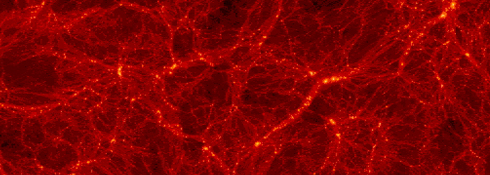 Galaxies and Observational Cosmology
Galaxies and Observational Cosmology
PI: Polychronis Papaderos (since 21 January 2013)
Team members
We aim to provide world-class contributions to the understanding of the origin and evolution of the universe and its large-scale structures. Our strategic focus is on the observational aspects of cosmology and extragalactic astronomy (ranging from the radio to the X-ray), but our multi-disciplinary expertise and interests encompass theory, phenomenology, high-performance computing and astrophysical instrumentation. We are exploring both the properties of the building blocks of the universe (galaxies and clusters) and its underlying mechanisms (structure formation, dark energy and fundamental physics).
Galaxies
Task leader: Andrew J. Humphrey
 Image credit: Hubble Space Telescope
Image credit: Hubble Space Telescope
Our work on the building blocks of the universe aims to characterize their properties and understand the physical processes that influence their evolution. We study nearby star-forming dwarf galaxies, namely as a template for starburst high-redshift galaxies, as well as the continuing assembly of massive galaxies through merging. We are also interested in characterizing the gas content, star formation and nuclear activity in galaxies, and their link with the larger-scale environment. Further, we are interested in the role of baryonic gas physics on the formation and evolution of groups and clusters of galaxies. The gas properties provide clues to the environmental influence on the galaxy population and are a proxy for the total mass of galaxy clusters, allowing for their use as cosmological probes.
Observational Cosmology
Task leader: Pedro T. P. Viana
 Image credit: Bolshoi Simulation
Image credit: Bolshoi Simulation
The focus of our study of the underlying cosmological mechanisms is in identifying and exploiting optimal discriminating tools between competing paradigms. We are interested in observational tests that allow us to distinguish between the standard inflationary paradigm of cosmological structure formation and its alternatives. We are providing a thorough characterization of viable dynamical dark energy models and identifying ways in which one may distinguish them from the standard (cosmological constant) paradigm. Whether we start from models motivated from fundamental theory or from phenomenological toy-models, our expertise allows us to exploit the full range of their astrophysical consequences (including their non-linear regime, through N-body simulations). We envision the universe as a laboratory in which to search for new physics, and actively pursue the suggestion that nature's fundamental dimensionless couplings may be spacetime varying (which would demonstrate the breakdown of Einstein's gravity). We are providing new spectroscopic and CMB measurements of these couplings and studying the ensuing theoretical implications.
The Team members are involved in several international collaborations: Euclid Consortium; CALIFA Survey; Sloan Digital Sky Survey; XMM-Newton Cluster Survey; Planck CMB and secondary anisotropies working group. We are actively contributing to the preparation of present and future data mining in these experiments, as well as exploiting possibilities for future facilities like the ATHENA and COrE-II satellites and the ALMA interferometer.
The activities of the team are supported by the following funding projects:
The Dark Side of the Universe
The Bulgeless Side of Galaxy Evolution
Fundamental Physics Tests with Planck
 Image credit: Hubble Space Telescope
Image credit: Hubble Space Telescope Galaxies and Observational Cosmology
Galaxies and Observational Cosmology
 Image credit:
Image credit: 